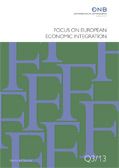Focus on European Economic Integration Q2/18
 OeNB
OeNB
- published:
- June 2018
 OeNB
OeNB
Call for applications: Visiting Research Program (PDF, 53 kB) en May 30, 2018, 12:00:00 AM
Developments in selected CESEE countries: Strongest economic upswing since 2008 amid booming domestic demand (PDF, 1.1 MB) en May 30, 2018, 12:00:00 AM
Outlook for selected CESEE countries: Boom in CESEE-6 has peaked, stable but moderate growth in Russia (PDF, 228 kB) en May 30, 2018, 12:00:00 AM
Digging into the composition of government debt in CESEE: a risk evaluation
(PDF, 1.6 MB)
Eller, Holler.
This paper reviews the composition of government debt in Central, Eastern and Southeastern Europe (CESEE) with a particular focus on the related risk implications, using a unique dataset compiled from various sources. The comparatively strong increase in government debt Levels recorded
in CESEE since the global financial crisis (GFC), together with an increased role of foreign portfolio investors with a typically short-term orientation, has accentuated refinancing risks. Nevertheless, on the aggregate level, refinancing and interest rate risks have been reduced in CESEE as governments increasingly have been able to issue longer-term debt instruments. At the same time, however, risks are not distributed equally across CESEE: there are still a few countries that record sizeable short-term debt (partially denominated in foreign currency) and/or are likely to face pronounced repayment spikes in the period up to 2025. The combination of an
increased debt stock and a dominant share of foreign currency-denominated government debt also implies substantial exposure to exchange rate risks in a few CESEE countries. Historical default episodes underline the riskiness of the large shares of foreign currency-denominated government debt that are often observed for countries with less developed capital markets. The issuance
of debt instruments which are exposed to high refinancing and rollover risk is only partially driven by debt management strategies; it is also a direct consequence of domestic financial market conditions. Therefore, special emphasis should be placed on fostering CESEE capital markets to strengthen government borrowing at home and in the local currencies and to further
develop derivative products to hedge interest and exchange rate risk.
en
government debt structure, public debt management, sovereign risk, Central, Eastern
E62, H12, H63, P35
May 30, 2018, 12:00:00 AM
Explaining the impact of the global financial crisis on European transition countries: a GVAR approach
(PDF, 544 kB)
Hoxha.
This study investigates how GDP and financial shocks in the EU-15 are transmitted to European transition countries, using a global vector autoregression (GVAR) approach. Our GVAR model is estimated for 32 countries over the period from Q1 1999 to Q4 2014. The results indicate
that, while the estimated spillovers from negative shocks to GDP and financial stress in the EU-15 to European transition countries are always negative, the size of these effects varies considerably across regions. Notably, the Baltic countries’ GDP levels show the most severe and statistically significant impact from the shocks to both GDP and the financial stress index in the EU-15. Both types of shocks to the EU-15 appear to be propagated mainly through foreign
credit flows, FDI and remittances, suggesting that the financial channel, particularly foreign credit flows, play a major role in the transmission of shocks to the Baltic countries. The examined Southeastern European (SEE) countries, on the other hand, are affected mainly by shocks to EU-15 GDP, which are propagated predominantly through exports, FDI and foreign
credit flows. EU Member States in Central, Eastern and Southeastern Europe (CESEE) are less severely affected by shocks to EU-15 GDP, possibly because they represent more advanced transition countries and are better able to offset crisis effects and thus contribute to the resilience of the region.
en
global financial crisis, transition countries, GVAR
F15, F30, G01
May 30, 2018, 12:00:00 AM
Statistical annex (PDF, 167 kB) en May 30, 2018, 12:00:00 AM